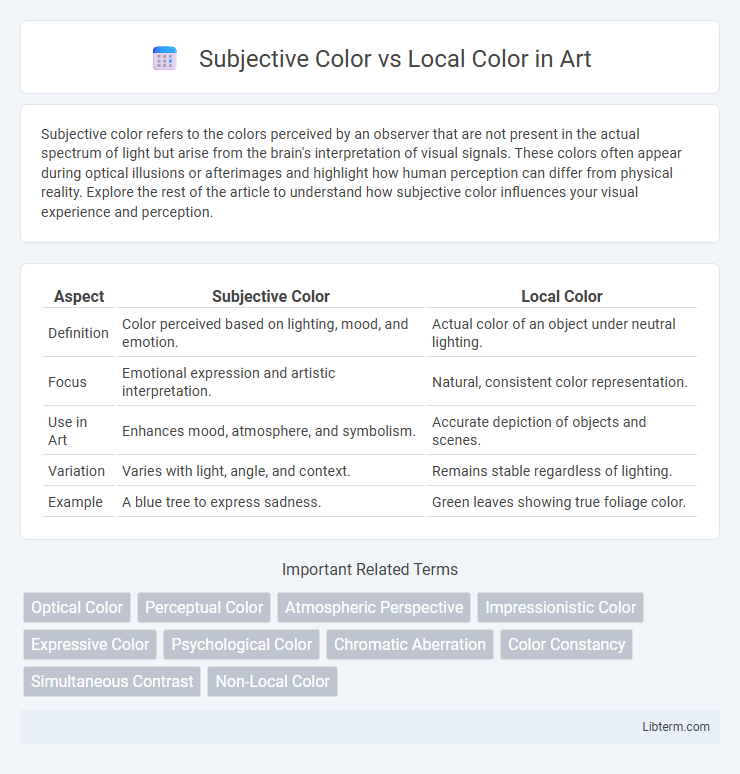Subjective color refers to the colors perceived by an observer that are not present in the actual spectrum of light but arise from the brain's interpretation of visual signals. These colors often appear during optical illusions or afterimages and highlight how human perception can differ from physical reality. Explore the rest of the article to understand how subjective color influences your visual experience and perception.
Table of Comparison
| Aspect | Subjective Color | Local Color |
|---|---|---|
| Definition | Color perceived based on lighting, mood, and emotion. | Actual color of an object under neutral lighting. |
| Focus | Emotional expression and artistic interpretation. | Natural, consistent color representation. |
| Use in Art | Enhances mood, atmosphere, and symbolism. | Accurate depiction of objects and scenes. |
| Variation | Varies with light, angle, and context. | Remains stable regardless of lighting. |
| Example | A blue tree to express sadness. | Green leaves showing true foliage color. |
Understanding Subjective Color
Subjective color refers to the perception of color influenced by personal feelings, emotions, and psychological factors rather than the actual wavelengths of light, which distinguishes it from local color, the true color of an object under neutral lighting conditions. Understanding subjective color emphasizes how ambient light, context, and individual experience shape color interpretation, impacting artistic expression and design choices. This phenomenon highlights the importance of perception variability, making subjective color crucial in visual communication and color theory studies.
Defining Local Color
Local color refers to the inherent, natural color of an object as perceived under neutral lighting conditions, independent of shadows, reflections, or color shifts caused by ambient light. It is the true color property that remains constant regardless of the surrounding environment or the observer's perspective. Understanding local color is essential for accurately representing objects in art, computer graphics, and color science, as it establishes a baseline before subjective hues or lighting effects alter perception.
Key Differences Between Subjective and Local Color
Subjective color refers to the personal perception of color influenced by lighting, mood, and individual experience, whereas local color is the true, consistent color of an object under neutral lighting. Key differences include that local color remains constant regardless of environmental changes, while subjective color varies based on context and observer interpretation. Understanding these distinctions is essential in fields like art and design to accurately represent or creatively manipulate color perception.
Historical Perspectives on Color Interpretation
Historical perspectives on color interpretation reveal that subjective color emphasizes the perceptual and emotional responses individuals have to color, often influenced by cultural and psychological factors dating back to early art theories in the Renaissance. Local color, rooted in scientific observation, represents the intrinsic color of objects under neutral lighting, a concept formalized during the Enlightenment as artists and scientists sought objective representation. The evolution from local to subjective color highlights the tension between empirical reality and personal experience in art history and color theory.
Subjective Color in Art Movements
Subjective color in art movements emphasizes the artist's personal interpretation of hues based on emotion and imagination rather than realistic representation, contrasting with local color, which depicts the object's true color under neutral lighting. Expressionism and Fauvism prominently utilize subjective color to evoke mood and convey emotional intensity, often employing unnatural, exaggerated hues to enhance psychological impact. This approach challenges traditional color theory by prioritizing individual perception and symbolic meaning over objective accuracy.
Local Color in Realism and Representation
Local color refers to the inherent color of an object as perceived under neutral lighting, essential in realism for accurate depiction of scenes. Artists employing local color in representation emphasize true-to-life hues to convey precise material qualities and spatial relationships. This focus enhances visual authenticity, allowing viewers to experience the depicted environment as naturally as possible.
Psychological Effects of Subjective Color
Subjective color, unlike local color which represents an object's inherent hue, is influenced by an artist's emotional response and psychological state, creating color perceptions that evoke mood and atmosphere. This use of subjective color can intensify emotional engagement by altering viewers' interpretations and feelings, often triggering specific psychological responses such as calmness, excitement, or unease. Studies in color psychology show that subjective color application enhances the communicative power of artwork by eliciting subconscious reactions based on cultural and personal associations.
Techniques for Using Subjective and Local Color
Techniques for using subjective color emphasize emotional impact by altering hues and intensities to evoke mood, often deviating from natural appearances to convey feelings or thematic elements. Local color techniques prioritize the true, observable color of objects under neutral lighting, ensuring realistic representation and spatial coherence within a composition. Combining both approaches, artists balance accurate color depiction with expressive manipulation, enhancing visual storytelling through strategic contrasts and color harmonies.
Impact on Viewer Perception
Subjective color, influenced by an artist's emotional intent or light conditions, can dramatically alter viewer perception by evoking specific moods or psychological responses. Local color refers to the inherent or natural color of an object, providing a reliable visual reference that grounds the viewer's understanding of the scene. The interplay between subjective and local color shapes the overall impact on audience interpretation, guiding emotional engagement and cognitive recognition.
Choosing Between Subjective and Local Color in Your Art
Choosing between subjective color and local color in your art depends on the emotional impact and realism you want to convey. Subjective color uses imaginative or expressive hues to evoke mood and atmosphere, while local color reflects the true, natural colors of objects. Balancing these approaches enables artists to create visually compelling works that resonate both emotionally and visually with their audience.
Subjective Color Infographic

 libterm.com
libterm.com